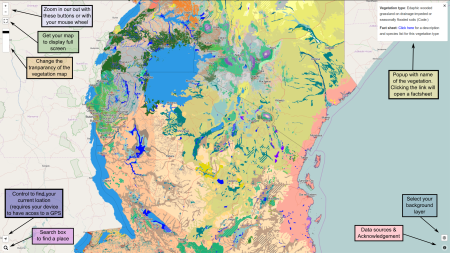Much excitement at the World Forestry Congress yesterday over the launch of the World Agroforestry Center’s fancy-shmanzy new app.
New app 4 identifying+selecting the right tree launched today! Try it. http://t.co/kLUCvjFJAN #Forests2015 pic.twitter.com/mPq4EG7lpw
— CIFOR-ICRAF (@CIFOR_ICRAF) September 7, 2015
Long story short, it’s version 2 of a potential natural vegetation map of eastern and southern Africa. 1 You can consult it in a browser, including on mobile devices, in Google Earth, or in your own GIS. Once you know where you are, or where you’d like to grown some trees anyway, you can get an idea of the natural vegetation there, and of what species might do well, for a variety of different purposes (honey production, say, or firewood).

Once you’ve selected a likely tree, you can get more information on it from ICRAF’s Agroforestry Species Dashboard. It’ll need a bit more road-testing than I have time for just at the moment, but it looks promising at first blush. One immediate reaction I do have is that it’s not possible to look for species that fulfil multiple functions: honey production and firewood, in other words. But I may be doing the thing an injustice.
- Kindt R, van Breugel P, Orwa C, Lillesø JPB, Jamnadass R and Graudal L (2015) Useful tree species for Eastern Africa: a species selection tool based on the Vegetationmap4africa map. Version 2.0. World Agroforestry Centre (ICRAF) and Forest & Landscape Denmark. http://vegetationmap4africa.org
Thanks for the review! A quick comment on the ability to look for species that fulfill multiple functions.
On each vegetation fact sheet there is a link to an excel workbook which lists the species and all their functions of that vegetation types. It allows you to do searches using multiple criteria using filters. See also the short tutorial.
Absolutely correct, and I’ve just successfully tested it. Thanks for the tip. I do have to say, though, that given the sophistication of the rest of the interface, having to play about with Excel spreadsheets is a slight let-down.
This is plain daft. “lists of the “useful tree species” that are expected to naturally occur in each vegetation type – and therefore also expected to be adapted to the environmental conditions where the vegetation types are depicted to occur on the map”. This assumes that `locally adapted’ species are adapted to local conditions. Obviously, otherwise they could not grow there – a meaningless observation. But they are not the only species that`might do well’ – they are certainly not `best adapted’. Lots of introduced trees and shrubs are `better’ than native ones. Just look at the jacarandas from Central America in Nairobi and all those eucalypts in Ethiopia (and hundreds more in plantation forests). And I do know what I am talking about – I worked for several years just along the bench from Peter Greenway, a good mentor and co-author of “Kenya Trees and Shrubs”. ICRAF should sort out the best trees and shrubs for the job, not a lot of native species hammered by native pests and diseases: we should be in the business of production (food, timber or whatever) rather than maintaining local parasitic biodiversity.